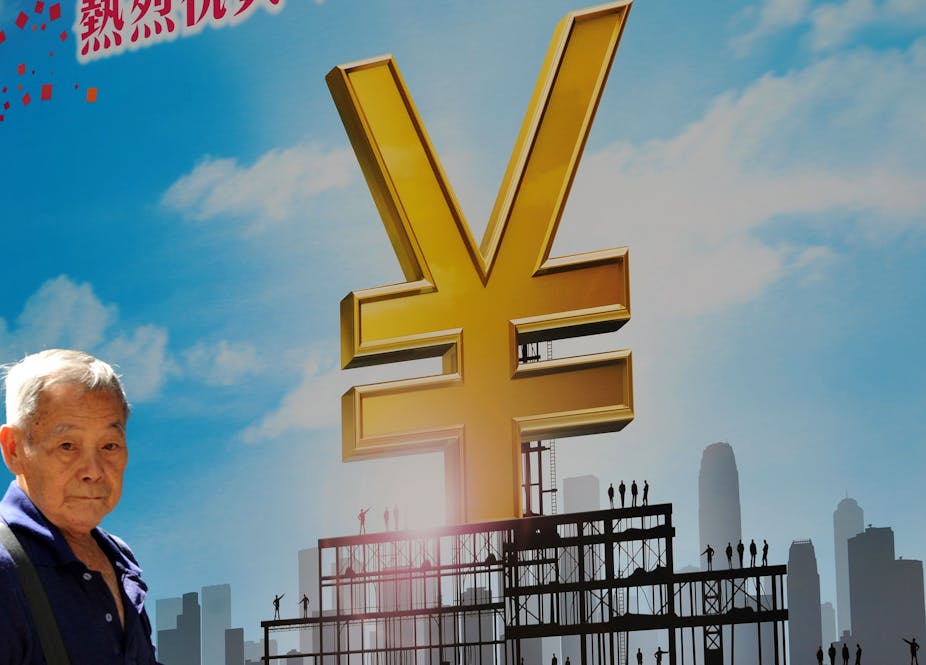In a speech in Sydney earlier this week, World Bank President, Robert Zoellick, lent his support to an appreciation of the renminbi (RMB).
As has become the norm, this support was couched in terms of an appreciation of the RMB being in China’s own best interests. But is it really?
There are three reasons usually given in support of this policy advice.
The first is that an appreciation of the RMB will narrow China’s trade surplus with the US. This will help to reduce political tensions between the two countries, which have centred on manufacturing job losses in the US.
The second is that an appreciation will help China rebalance its economy away from export-led growth towards more sustainable domestic demand drivers, such as household consumption.
The third is that an appreciation will give China’s central bank, the People’s Bank of China (PBC), greater monetary policy autonomy.
As long as the PBC is obliged to buy $US at a given rate, controlling the growth of the domestic money supply is difficult.
The situation is made worse by “quantitative easing” in the US, which has created a sea of cheap credit, some of which has found its way to China seeking higher returns.
However, the case for an appreciation of the RMB being in China’s own best interests is far from clear cut.
An immediate concern is the extent to which China’s current inflation problem is a monetary phenomenon.
China’s inflation rate now stands at 6.5%, a three year high, and is well above the target rate of 3%.
However, a disaggregation of the data shows that the main cause is rising food prices, which increased by 14.8% over the past year. The price of pork in China is not determined by capital inflows from abroad.
A more basic issue that China’s policy-makers face is deciding upon what constitutes an appropriate level for the RMB.
Sadly, economists are not much help here. There is no single definition of the equilibrium exchange rate, nor an agreed upon methodology for calculating it. As a result, estimates of RMB undervaluation that have appeared in academic studies since the mid-2000s have ranged from 0-50%.
Note that allowing the RMB to simply float freely is not a realistic option given the current state of financial architecture in China.
For example, Chinese exporters do not have ready access to risk management tools that Australian exporters take for granted, such as forward foreign exchange markets.
Another problem is that the value of the RMB is, in fact, only loosely related to China’s trade surplus with the US, or to rebalancing its own economy.
This should be obvious from the experience of recent years. Since the middle of 2005, the RMB has appreciated against the $US, by a substantial 30%.
Yet, according to the US Census Bureau, the US trade deficit on goods with China was $US202 billion in 2005 and $US273 billion in 2010. And this was despite an extremely sluggish US economy over the period 2008-2010 that presumably depressed imports.
The household consumption share of GDP in China also continued to decline over the same period.
There are many reasons why China’s trade is not particularly sensitive to exchange rate fluctuations.
One is the importance of processed exports. More than half of China’s exports consist of goods that are merely assembled in China using imported components.
The value-added in China is often extremely limited and a stronger RMB makes imported components cheaper.
More than half of China’s “exports” are also produced by foreign companies, including from the US, who have invested heavily in establishing production facilities there.
Such location decisions are based on factors far more fundamental than the prevailing exchange rate, such as the availability of quality infrastructure, and low cost, well-educated labour.
It is also important to note that growth drivers in China cannot simply be switched, especially with an instrument as blunt as the exchange rate.
For example, the low household consumption share of GDP in China reflects deep-seated structural problems in the economy, such as a financial system that does a poor job of returning profits of the corporate sector to households.
An appreciation of the RMB, particularly if it were sudden and sharp, would penalise exports and result in job losses, but do little to increase the household income share of GDP.
A final consideration is that for all the attention given to the value of the RMB against the $US, it is not the only exchange rate.
Indeed, it may not even be the one that matters most. For example, this year the RMB has been appreciating against the $US, but its real effective exchange rate has actually been depreciating.
The real effective exchange rate takes into account, amongst other things, the composition of China’s trade.
China’s trade with the EU is actually greater than its trade with the US.

